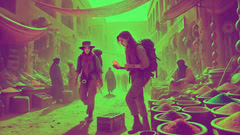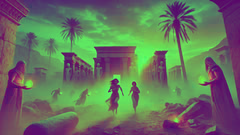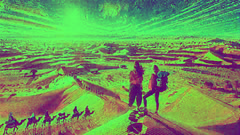Introduction
The story of the Nabooti jewels did not begin in a windswept North African marketplace but in a bustling Harlem apartment dappling with late sun. Crystal and Maxine Carter, siblings raised on their father’s tales of far-flung adventure and trade, hardly believed their lives would veer from workaday rhythms of New York City into a quest echoing down the centuries. Yet one fog-chilled autumn morning, a battered parcel arrived—postmarked Casablanca, papers inside yellowed with age, sealed in a blink of desert sand. It contained a plea for help from their great-uncle Elijah, long considered the family’s eccentric. Beneath the desperate scrawl: sketches of intricate amulets, a map that almost looked burnished by centuries, and two faded photographs. One showed a glinting necklace of impossible colors, the fabled Nabooti jewels—rumored to be gifts to a lost Saharan kingdom, and the source of a family legacy.
As a child, Crystal knew the story: the Nabooti, a nomad people who bartered in gold, arcane wisdom, and rare stones, had vanished. Rumor said betrayal and greed buried their treasures somewhere on a trade route that sliced the Sahara from Timbuktu to the Mediterranean. Some believed Elijah had spent his life tracing rumors, always a step behind rival treasure hunters and smugglers with far fewer scruples.
Moving between the sharp thunder of the Manhattan subway and the desert’s mythic silence would test any resolve. But the urgency in Elijah’s note, and the thrill of a mystery—and perhaps a fortune—proved irresistible. The same day, the siblings booked tickets overseas. Crystal, the planner and skeptic, packed books and sturdy boots. Maxine, ever the enthusiast, brought binoculars, a compass, and hope. As they traced Elijah’s clues from American docks to Tangier’s labyrinthine alleys, every scent, neon flash, and unfamiliar tongue began to weave another story.
In the months that followed, their journey would demand more than cleverness. The Carter sisters would have to decipher riddles from half-lost dialects, escape would-be kidnappers, and forge uneasy alliances with desert guides, all while relentless rivals stalked their every step. In a world where every alley or oasis might hold a friend, a thief, or a secret, the only certainty was this: To find the Nabooti jewels, they’d have to cross not just the Sahara, but the shadowy boundaries between myth and reality, loyalty and ambition, the past and the futures they dared hope for.
From Harlem to the Desert Edge
Crystal and Maxine stepped off the plane under a North African sun that seared the air and made everything pulse with heat. Casablanca was chaos: porters barked over crates of copper, the call to prayer hung over the din, and French, Arabic, English mixed—every language but clarity. An old ally of Elijah, Abdel Salim, met them with a battered Peugeot, his salt-and-pepper beard bristling as he whisked them from the airport to a market thick with spice and past secrets. Abdel, cryptic and careful, pressed a small pouch into Maxine’s hands: inside, a fragment of carved carnelian, bearing a Nabooti script that pulsed as if longing to be reunited with its kin.

“We are not the only ones searching for these jewels, chéries,” Abdel murmured, eyeing the crowd. He pointed to the map’s crimson markings, crossing from Tangier through the Draa Valley and deep into the Tanezrouft. Anyone tracing that line crossed centuries; if they survived betrayal, thirst, and sand.
Their first night, menacing shadows prowled the walls of their riad. A coded message stashed in a market stall—a phrase only Elijah would use: ‘Beware of the Blue Tuareg’. The next morning, a thief tried to pickpocket Crystal, but she seized his wrist. Instead of a struggle, the youth gasped, “Don’t trust the Frenchman with the scar!” before slipping away.
By bus and battered truck, they followed the mapped clues: a ruined minaret whose shadow at noon pointed to a hidden well, a merchant in Zagora offering a prayer bead bracelet with a missing charm—a sign pointing their route. Camels became their only way forward when roads turned to salt and the trade wind reduced all sound to whisper.
Maxine awed at the caravan trains—lines of camels laden with salt, spices, and sometimes strange boxes, their handlers sun-blackened and wary. Life on the Sahara’s edge was measured in water, shade, and who owed whom. A tough Tuareg guide, Leïla, agreed to join them, haunted by secrets of her own. She schooled them in survival: “Travel at sunrise or dusk. Bury your water. Never boast about what you seek.”
In every small village, children sang fragments of the Nabooti legend. Old women placed protections in the girls’ bags. Yet always, dangerous men seemed just behind—a Frenchman in mirrored sunglasses, a silent Russian, and a veiled trader whose laughter sent sand scurrying. Each night, Crystal pored over maps and coded letters by candle, Maxine guarded the camels and listened to Leïla’s stories of star navigation and deals struck by firelight. Then, on the first night beneath the vast Sahara stars, a coded cipher revealed their next destination: the Lost Oasis of Tisrawin. But it also warned, ‘The storm comes—trust only the one who knows the path of snakes.’
The Lost Oasis and the Mirage of Treasure
Nights in the Tanezrouft were velvet-black and cold. The trio pressed on, fighting sleep as Leïla charted their way by Orion’s belt. Progress slowed; supplies ran dangerously low. Their camels grew restless. Days seared and the mirages danced, tempting even those with iron discipline.

At the edge of sanity, a sandstorm barreled down—amber and gold swallowing the sun. The Frenchman with the scar overtook them, brandishing a rusted revolver and demands for Elijah’s maps. Leïla, swift as a snake, tackled him while Crystal flung a pouch of sand in his eyes. In the chaos, Maxine and Crystal plunged blindly into the roaring storm, shackling themselves to their camels, following the faint scent of sweet water that Leïla insisted would only appear to the worthy.
When the sand cleared, they found themselves at the edge of Tisrawin, an oasis hidden by bramble and legend—palms and acacia circled a spring surrounded by ancient stones. There they discovered a cache marked by Nabooti glyphs: a lacquered box filled with scrolls, amber beads, and a map of the old Saharan roads. Maxine realized the carnelian fit into a central slot, unlocking a hidden compartment—inside, a sapphire amulet reflecting all the colors of mirage. With it, a faded letter from Elijah: “The Nabooti jewels lie not in one place but many. They must remain apart until Nabooti’s heirs gather them under the Date Palm Star.”
Yet safety never lasted. Rival hunters closed in, and Crystal, piecing together coded star maps, realized they had a traitor in their party. Leïla’s loyalty seemed waning; her stories grew cagey and fragmented. At dawn, a shadow tried to snatch the jewels—Leïla revealed herself as Elijah’s old ally, not foe, intercepting the thief and vanishing into the palm thicket, leaving behind a warning: “The real prize is yet unseen.”
Uniting the scrolls and sapphire with the carnelian, Crystal and Maxine charted the next leg. The map pointed toward the ancient necropolis of Nabooti, said to vanish beneath the moon and appear in full only when the Saharan winds calmed for three days. Determined, the sisters pressed on—grappling with lost wells, salt caravans reluctant to share paths, and rivals still nipping at their heels. At the necropolis, faded carvings matched their tokens. Crystal’s knowledge of languages proved vital; a coded riddle etched in ancient stone warned of a final guardian: ‘Only the patient, who honor the dead, may retrieve the desert’s splendor.’
The Tomb of Nabooti and Reunion Under the Date Palm Star
Time ran short. Trevor, the Russian dealer, and two Tuareg deserters tracked them across the sands. At night, drums echoed far off; at dawn, mirages shimmered into unfamiliar faces. Weariness gripped Crystal and Maxine, but the twin push of family and adventure spurred them on.

The necropolis loomed out of morning mist—pillars of white stone patterned like a cracked eggshell, scattered between petrified date palms. Crystal traced glyphs and fit the sapphire into a carving shaped like a serpent. The ground shuddered gently. A concealed crypt opened beneath their feet. Lamp in hand, they descended. Walls flared with ancient paintings—merchants weighing gold, camel trains crossing the waste, kings with jeweled collars. There, at the heart of the crypt, rested a casket draped in Nabooti silk. Inside: not a trove, but a letter from Elijah himself—delivered through secret allies—beside a single heavy necklace. Its stones shone with impossible hues. It was the heart of the Nabooti treasure.
A commotion at the crypt’s mouth: the Frenchman and two others demanded the jewels. Maxine, thinking fast, invoked the guardian’s riddle—she laid down every treasure, gave up the maps, and invited the rivals to pay respects to Nabooti’s ancient queen, resting peacefully below. As the rivals bickered, a sandstorm roared in, sealing the crypt’s mouth and forcing them to retreat. Crystal and Maxine, protected by Leïla’s signal fire near the palm ring, slipped out through a secret passage. The crypt’s storm-carved entrance buried itself, hiding the path once more.
At sunset they arrived at a trading post filled with noise and music. Elijah was there—alive, older but grinning. “The Nabooti jewels are safe only in stories and in the hands of their guardians. The legend lived because no one seized it for selfish gain.” He embraced them both. That night, under the ‘Date Palm Star’—Venus bright in a purple sky—keepers of the Nabooti line gathered. The jewels were divided, not hoarded, and entrusted to worthy guides, traders, and scholars so that greed could never claim the full trove again.
The next morning, with passports tucked against their hearts and promises secured, Crystal and Maxine began their journey home. The adventure had changed them: sands in their boots, secrets in their smiles, and the sense they’d become as much a part of the Nabooti tale as their ancestors before them.
Conclusion
Across the centuries and continents, the lost jewels of Nabooti remained not merely a fortune but a symbol: only the brave, resourceful, and wise would find and hold them, and they must do so with humility. Crystal and Maxine, back in New York, became trusted storytellers—guardians not merely of stone and gold, but of the lessons learned crossing the ancient trade routes: trust but question, endure when hope thins, and remember that every place holds secrets its people guard as fiercely as their treasures. As legends passed from Harlem to the Sahara and back, new adventurers would follow the tale, each learning anew that sometimes, what is lost is not truly missing, but simply waiting for the right seeker beneath the endless, sunlit sands.













